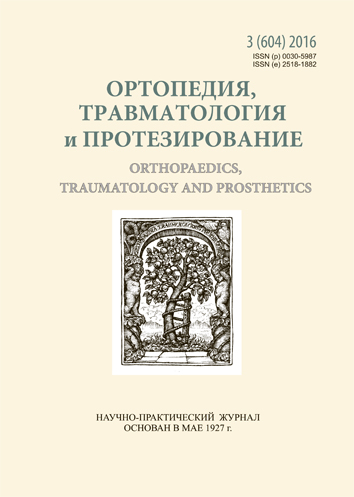Diaphyseal fractures of the humerus. How to treat conservatively and when needed surgery?
DOI:
https://doi.org/10.15674/0030-59872016396-103Keywords:
diaphyseal fractures, humerus, the rationale of treat¬ment techniques, functional treatment, osteosynthesisAbstract
According to the Kharkiv interdistrict MSEK (2012) using of internal osteosynthesis results into high incidence of nonunion of the humeral fractures — 24 % 4 months after plating.
Purpose: to justify treatment guidelines of diaphysial humeral fractures using 30-years scientific and practical experience for presenting an improved method of treatment and to present achieved results.
Methods: To evaluate the results of treatment in 73 patients with humeral fractures treated from 2006 to 2014. Functional conservative treatment with orthosis — 39 people, external fixation device (EFD) — 16 (13 after closed reduction, open 3). In 18 patients applied internal osteosynthesis. Clinical material is analyzed since 1984 (104 cases).
Results: main features that influence the choice of treatment method such as the displacement of the bone fragments in the initial radiograph, fracture level, other damage, limiting the mobility of the injured, the condition of the radial nerve are distinguished and characterized. Details of functional treatment of fractures of the humerus with the cast and pin EFD are presented.
Conclusion: in a case monolocal diaphyseal fractures of the humerus one should choose a conservative functional treatment method — the safest in case of complications, providing fusion of fragments in a short time, well-tolerated by patients and requiring low material costs. For a fixed displacement of fragments greater than the diameter of the bone, and associated lesions, excluding or significantly limiting the vertical position of the patient, it is advisable to use EFD. Open reduction is required for the displacement of bone fragments in the full width, irremovable hanging shoulder position within 2–5 days. Revision of the radial nerve is indicated with considerable fixation and displacement of bone fragments.References
- Litvishko V, Uzhigova O. Treatment of diaphyseal fractures of extremities in conditions of traumatology departments of central district highway hospitals. Orthopaedics, Traumatology and Prosthetics. 2012;(2):68-73. doi: 10.15674/0030-59872012268-73.
- Litvishko V. «The behaviour» of bone fragments during functional treatment of humerus diaphyseal fractures. Orthopaedics, Traumatology and Prosthetics. 1998; (1):98-100.
- Litvishko V. Functional treatment of humerus diaphyseal fractures. Summary of thesis for the scientific degree of the candidate of medical sciences; 14.00.22 in specialty 14.01.21 – Traumatology and Orthopedics. Kharkiv, 1999. 20 p.
- Popsuishapka O, Litvishko V. The treatment of diaphyseal fracture of the humerus using splint-tissue orthosis. Orthopaedics, Traumatology and Prosthetics. 1998;(3):90-3.
- Popsuishapka O. The functional treatment of diaphyseal fractures of bones of extremities (clinical and experimental basis). Thesis for the scientific degree of the doctor of medical sciences; 14.00.22 in specialty 14.01.21 – Traumatology and Orthopedics. Kharkiv, 1991. 273 h.
- Popsuishapka O, Litvishko V, Borovik I. The functional treatment of diaphyseal fractures of extremities with use of rod external fixators for elastic and resistant connection of bone fragments. Guidelines. Kiyv, 2014. 46 p.
- Sarmiento A, Latta LL. Closed functional treatment of fractures. Berlin; Heidelberg; N. Y.: Springer Verlag, 1981. 687 p.
Downloads
How to Cite
Issue
Section
License
Copyright (c) 2016 Valeriy Litvishko

This work is licensed under a Creative Commons Attribution 4.0 International License.
The authors retain the right of authorship of their manuscript and pass the journal the right of the first publication of this article, which automatically become available from the date of publication under the terms of Creative Commons Attribution License, which allows others to freely distribute the published manuscript with mandatory linking to authors of the original research and the first publication of this one in this journal.
Authors have the right to enter into a separate supplemental agreement on the additional non-exclusive distribution of manuscript in the form in which it was published by the journal (i.e. to put work in electronic storage of an institution or publish as a part of the book) while maintaining the reference to the first publication of the manuscript in this journal.
The editorial policy of the journal allows authors and encourages manuscript accommodation online (i.e. in storage of an institution or on the personal websites) as before submission of the manuscript to the editorial office, and during its editorial processing because it contributes to productive scientific discussion and positively affects the efficiency and dynamics of the published manuscript citation (see The Effect of Open Access).














